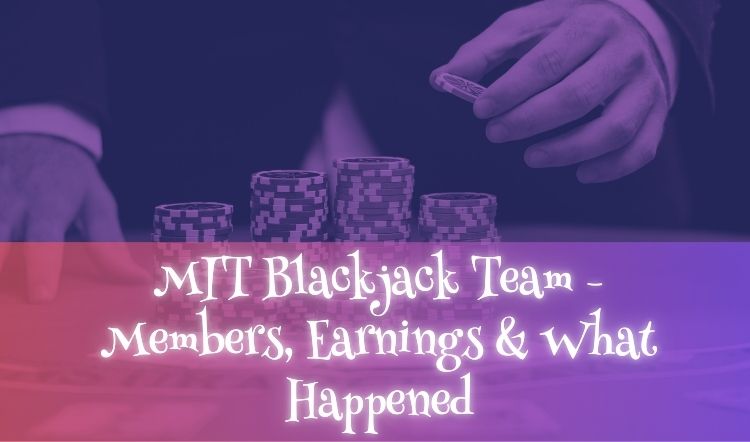
The MIT Blackjack Team is one of the most well-known stories in the world of casino gambling. Their tale combines mathematics, teamwork, and controversy.
In this blog, you’ll learn who they were, what they reportedly earned, and what became of them once casinos caught on to their methods. By breaking down fact from myth, we’ll explore how this team left such a mark on blackjack history, and why their story continues to be told decades later.
Who Were The MIT Blackjack Team?
The MIT Blackjack Team was made up of students and graduates from top universities in the United States, including the Massachusetts Institute of Technology (MIT), Harvard, and others. Despite the name, it was never limited to MIT alone.
Their interest centred on blackjack, a card game where players try to reach a hand total of 21, or as close as possible without going over, while competing against the dealer. Unlike roulette or slot machines, blackjack involves decisions that can influence the outcome of a hand.
Some mathematically minded players discovered that keeping track of which cards had already been dealt — known as card counting — could help them predict when the game was more favourable.
Bill Kaplan, who had previously run a successful blackjack team in Las Vegas, joined forces with MIT students in 1980. With his business-like approach, they set up training, strict tests for new recruits, and a structured way of dividing roles.
Team members rehearsed in hotel rooms and classrooms before ever sitting at real casino tables. Their method turned what might have been a small student experiment into a professional-style operation.
MIT Blackjack Team Earnings
Precise earnings are hard to confirm because the team operated privately and split into different groups over the years. However, credible reports from former players and investigative journalists suggest that the team  collectively made several million dollars between the early 1980s and the late 1990s.
collectively made several million dollars between the early 1980s and the late 1990s.
Blackjack is a game that involves an element of chance, and no strategy, including card counting, can ensure success in every hand, session, or trip. The MIT Blackjack Team believed that with careful organisation their approach might offer an advantage over time. To make this possible, they secured funding from investors, covered expenses such as travel, and shared any profits between the players and those who provided the financial backing.
While popular accounts often highlight big wins in Las Vegas, members have explained that the results were uneven. There were good days and bad days, sometimes even bad months. What mattered most to them was the long-term outcome, not individual streaks.
MIT Blackjack Team Members
The team included dozens of people over two decades. Some stayed briefly, while others became central figures. Notable names include Bill Kaplan, John Chang, Laurie Tsao, Mike Aponte, Jane Willis, and Jeff Ma.
At its height, around 60 or more individuals were involved in one way or another, although fewer were active at the same time. To avoid drawing attention in casinos, members often used code names and silent signals at the table. Each role was carefully planned:
-
Spotters played low stakes while tracking the count.
-
Big players entered when the count was favourable and bet much larger sums.
-
Controllers coordinated strategy and ensured the system ran smoothly.
This teamwork allowed them to fly under the radar for longer than solo counters. Casinos were familiar with individuals trying to count cards, but a coordinated group was harder to detect — at least at first.
Did The MIT Blackjack Team Go To Jail?
The team did not go to jail. Card counting itself is not illegal. It involves using your memory and observation, not any device or outside help. That said, casinos strongly oppose it because it can give players a statistical  edge.
edge.
If someone was suspected of card counting, casinos could ask them to leave and in some cases ban them from returning. While casinos under the same licence could share information about players, they could not pass details freely between unrelated operators. To make card counting more difficult, many casinos also introduced countermeasures, such as:
-
Using multiple decks rather than a single pack of cards.
-
Shuffling earlier or more often to disrupt counting.
-
Introducing automatic shuffling machines.
-
Training staff to spot any unusual betting patterns.
These changes made card counting more difficult and reduced the team’s effectiveness.
What Happened To The MIT Blackjack Team?
By the mid-1990s, the team had grown large and had split into separate groups, sometimes known as “banks”. They continued for a few more years, but as casinos tightened their rules and staff became better trained, their operations became less successful. By around 2000, the organised groups had largely disbanded.
Afterwards, many members moved on to other careers. Bill Kaplan invested in property and business. John Chang stayed connected to blackjack for some time, but stepped back from the spotlight. Jeff Ma worked in technology and media, and Mike Aponte later became involved in blackjack education.
Their story reached a wider audience through Ben Mezrich’s book Bringing Down the House and the Hollywood film 21. Both captured elements of what happened, but also mixed in fiction, so not every detail should be taken as fact.
The story of the MIT Blackjack Team highlights that even the most disciplined players cannot avoid uncertainty in casino games. Blackjack, like all gambling, carries an element of chance, and no strategy can secure consistent winnings.
If you choose to gamble, it helps to decide beforehand what you are prepared to spend, treat it as entertainment rather than a way to earn money, and step away if it stops being enjoyable.
Casinos are designed to hold the advantage, so while tales of success such as the MIT team capture attention, they remain rare exceptions rather than the norm.
**The information provided in this blog is intended for educational purposes and should not be construed as betting advice or a guarantee of success. Always gamble responsibly.
